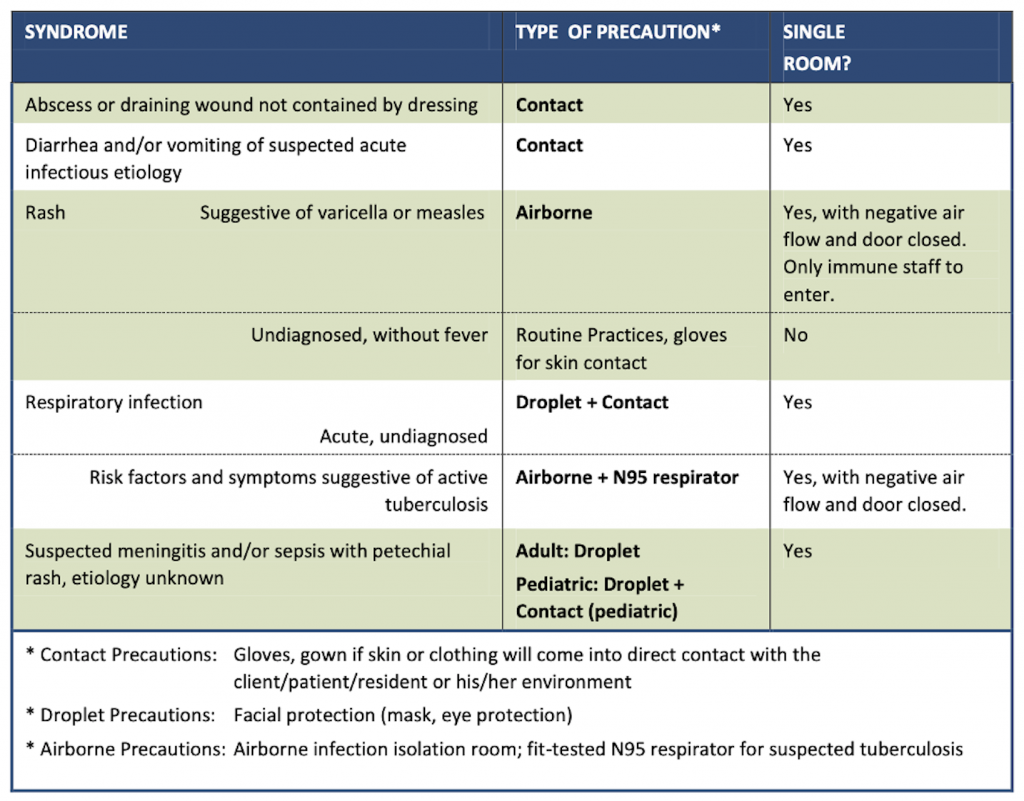Introduction to Additional Precautions
Certain pathogens and communicable diseases are easily transmitted and require additional precautions in addition to routine practices. Additional precautions include contact, droplet, and airborne precautions. These additional precautions interrupt the spread of suspected or identified infectious agents to healthcare providers, clients, and their visitors (Provincial Infectious Diseases Advisory Committee [PIDAC], 2012). The mode of transmission of the infectious agent influences the additional precautions required. If a client is i) suspected of having an infection because of their clinical presentation or ii) has been confirmed with an infection from a test result, healthcare providers must follow the additional precaution guidelines according to the healthcare setting protocol. Additional precautions include PPE, as well as specialized equipment (e.g., N95 respirator) and specific environmental protocols (e.g., room accommodation and placement, negative pressure engineered rooms, and advanced cleaning protocols). Another room accommodation is configuration of the negative pressure room that includes the use of an anteroom. The anteroom can be used to put on and remove PPE and perform hand hygiene. Ensure all healthcare providers and visitors follow the additional precautions policies.
Single rooms, cohorting (placing clients with the same infections in the same room if a private room is not available), restricting visitors, and implementing additional environmental controls may be required. You need to provide instructions to the client and their visitors and post signage that identifies the required PPE, and describes the appropriate use and disposal for clients, visitors, and healthcare providers. Once you leave the client’s isolation room, you need to remove PPE immediately. PPE is for single use only.
The type of hand hygiene required depends on the diagnosis. For example, you can use an alcohol-based hand gel for clients diagnosed with influenza or methicillin-resistant Staphylococcus aureus (MRSA). However, for clients diagnosed with C. difficile, you need to wash your hands with soap and water.
Types of Additional Precautions
There are three categories of additional precautions: i) contact precautions, ii) droplet precautions, and iii) airborne precautions. Some infections require multiple additional precautions. For example, influenza is considered a droplet contact additional precaution. Whereas COVID-19 can be considered all three categories, depending on the treatment being performed on the infected client.
Special Considerations with Additional Precautions
Points of Consideration: Additional Precaution Signage
If a client is suspected of having an infection because of their clinical presentation or has been confirmed with an infection from a test result, healthcare providers must follow the additional precaution guidelines according to the healthcare setting protocol. One of these guidelines includes posting the additional precaution sign onto the client’s door and communicating the client’s health status to the healthcare team.
The infection prevention and control department and the occupational health and safety department educate healthcare providers about the various additional precaution signage used in the healthcare setting (PIDAC, 2018). As a healthcare provider, it is important for you to understand the requirements related to each of the additional precaution signage (e.g., contact, droplet, airborne, or combination) and to follow the infection prevention and control guidelines to decrease the risk of transmission and support a safe working environment. Clear signage and timely communication about additional precautions is everyone’s responsibility.
The following chart by PIDAC (2012) describes clinical syndromes requiring additional precautions pending the client’s diagnosis.

Test your Knowledge
Attribution
This page was remixed with our own original content and adapted from:
Clinical Procedures for Safer Patient Care — Thompson Rivers University Edition by Renée Anderson, Glynda Rees Doyle, and Jodie Anita McCutcheon is used under a CC BY 4.0 Licence. This book is an adaptation of Clinical Procedures of Safer Patient Care by Glynda Rees Doyle and Jodie Anita McCutcheon, which is under a CC BY 4.0 Licence. A full list of changes and additions made by Renée Anderson can be found in the About the Book section.

